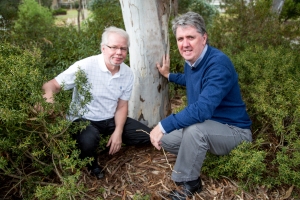On the trail of deadly Dieback
Research news
Many people have never heard of it, but Phytophthora - a fungus-like pathogen - is one of the world’s most devastating plant pathogens.
It has been estimated that it could cause up to $1.6 billion worth of damage in Australia over the next 10 years, and is wreaking similar havoc across the globe.
Nor is the Geelong region immune. Areas such as the Anglesea heathland and the Brisbane Ranges, along with many other parts of Victoria, such as the Xanthorrhoea grass tree open forests around Wilson’s Promontory, are also being invaded by Phytophthora.
A world expert in Phytophthora, Professor Wolfgang Osswald, from the Technical University of Munich, is currently spending five months in Geelong as a “Thinker in Residence” within Deakin’s School of Life and Environmental Sciences - helping to contribute to Australia’s battle against the disease.
He is working with Deakin’s own Phytophthora expert, Professor David Cahill, Associate Dean (Research) in the Faculty of Science, Engineering and the Built Environment, and his team in their quest to find ways to control the pest.
Along with colleagues from Western Australia, Brazil and Portugal, the two professors are world leaders in Phytophthora research.
“Having Wolfgang here at Deakin and Australia is giving us an exceptional opportunity to progress our work on this globally important group of organisms,” said Professor Cahill.
He explained that there are well over 100 species of Phytophthora, but it is “Phytophthora cinnamomi” that is responsible for the Dieback problems in a number of Australia’s native forests, as well as in our horticultural, eco-tourism and nursery industries.
Its spread within Australia - particularly in sensitive eco-systems such as those in south-west Western Australia and parts of Victoria - has the potential to be a biological disaster affecting more than 2000 plant species, with many potentially facing extinction.
“It is our native species that are most at risk, with phosphite spraying controlling its spread in horticultural and agricultural industries,” said Professor Cahill.
Phytophthora is not a new problem to the world. Phytophthora infestans was responsible for the potato famines of the 1840s, but globalisation has exacerbated its effects. Different species infect plants as diverse as potatoes, tomatoes, citrus, soybeans, tobacco and native forests.
In the UK, P. ramorum is currently decimating Japanese larches, while in California more than one million oak and tanoak trees have been killed over the past decade.
Both Professors Osswald and Cahill have spent their entire careers studying Phytophthora - fascinated by both its unique characteristics and the challenge to control it.
“It is a compelling pathogen that was originally categorised as a fungus, but Phytophthora is unique,” Professor Osswald explained. “It is like a fungus, but it is not a fungus, so it doesn’t respond to known fungicides.”
“Also, like a fungus, it has ‘resting spores,’ which means that it can stay dormant for many years within the soil and, when conditions are right, such as high rainfall, it wakes up and begins to infect plants through their root system.
“When conditions are optimal, so many factors come together, and once an epidemic has started, in most cases, it is too late to react. It’s like an avalanche.”
Professor Cahill explained that we have very limited options for control of Phytophthora in native forests and heathlands, but much progress has been made in the use of environmentally friendly chemicals and in the potential use of genetic modification of either the pathogen or the host plants.
“We have completed some trials of aerial spraying of phosphite around the Anglesea heathlands, to keep Phytophthora under control, but this is not a long-term solution.
"However, with new genetic information, we believe that there is hope in sight. We are looking at how Phytophthora interacts with plants so that we can develop ways to modify plant reaction and improve resistance.”
In the meantime, he added, it is important to control the spread of the pathogen within our forests, through following guidelines relating to trail bike and four wheel drive use, for instance.
Share this story
 Joining forces in the battle against Phytophthora: Professor Wolfgang Osswald (Technical University of Munich) and Deakin's Professor David Cahill (right).
Joining forces in the battle against Phytophthora: Professor Wolfgang Osswald (Technical University of Munich) and Deakin's Professor David Cahill (right).
